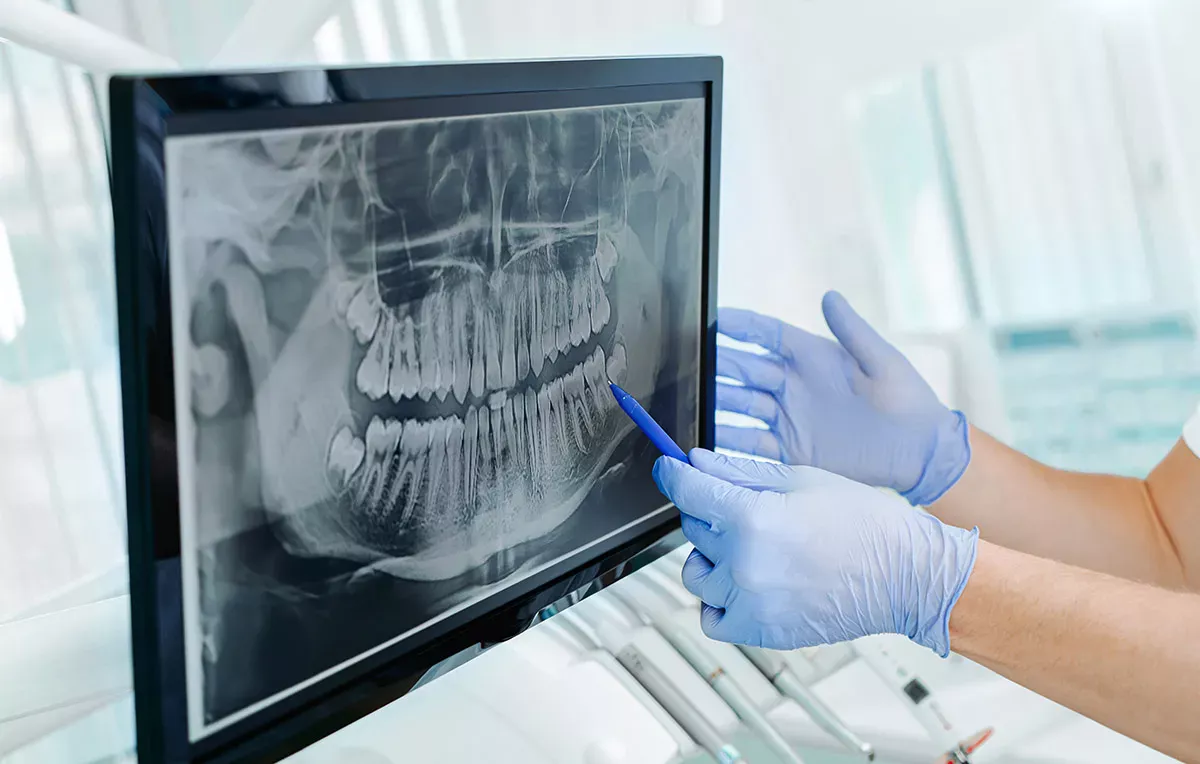Definition: What is a crack in a tooth?
Every child knows that teeth can develop cavities if they are not brushed regularly. However, a crack can also occur in the tooth if the tooth substance gives way and tears. This is also referred to as a fracture - just like a broken bone. The form can range from a slight transverse crack in the enamel to a vertical, continuous crack from the crown to the root. Cracks in the tooth are often very fine and can only be recognised by close examination with the eye. The crack can either affect only the enamel or also damage the deeper layer, the dentine. In the worst case, the crack extends into the pulp - the innermost layer of the tooth.
Causes: How do cracks develop in teeth?
Cracks in the tooth can occur in various ways. The effects of violence are often a factor; however, the enamel can also be damaged by acidic foods or thermal stimuli. How soft or hard the enamel is varies from person to person. In general, root-treated teeth and decayed teeth are more susceptible to cracks than healthy teeth.
Use of force
Dental trauma does not always mean that a tooth breaks or falls out. For example, cracks can occur in a tooth after a fall or impact. You should definitely have these examined by a dentist!
After root canal treatment, significantly less force is required to cause a crack in the tooth. For example, biting down on a cherry stone can be enough to crack the enamel.
Cracks in teeth in children
Dental trauma is relatively common in children, which can also lead to a crack in the tooth. While milk teeth are more likely to break off, cracks in teeth occur mainly in permanent teeth between the ages of seven and nine. Front teeth are damaged more frequently than molars. If you discover a crack in an incisor or other tooth in your child, you should have it examined and documented by a dentist.
Teeth grinding
A crack in the tooth can also be caused by grinding. When people grind their teeth at night, the enamel is subjected to a great deal of stress as the upper and lower jaws press and rub against each other with great force. The resulting pressure is significantly greater than when chewing.
Piercings
Piercings in the mouth area - especially large, elongated tongue piercings - can lead to a crack in the tooth, as they often push against the tooth enamel and permanently damage it. If you have a tongue piercing and the tooth has already cracked, you should remove the piercing.
Acidic foods
If you frequently eat acidic foods, this will damage your tooth enamel in the long term. This can cause cracks in the tooth over time.
Unhealthy foods with a high acid content are, for example:
- Sweets
- Soft drinks
- Cakes and pastries
- Alcoholic beverages
- Finished products
Good to know:
After eating or drinking acidic foods, you should wait 30 minutes before brushing your teeth. You are welcome to rinse your mouth with water immediately after eating to protect your teeth from demineralisation.
Root canal treatment
After root canal treatment, the risk of a crack in the tooth is not only higher than with a healthy tooth. The root canal treatment can also be the cause of the crack. This applies in particular to longitudinal fractures - i.e. vertical cracks in the tooth. They are often caused by errors during root canal treatment.
Large temperature differences
Tooth enamel reacts sensitively to temperatures. For example, if you drink something very hot outside in winter after your teeth have been in contact with cold air, the enamel may crack. The same applies to very cold drinks in summer. To avoid cracks in the tooth, it is better not to expose your teeth to extreme temperature differences.
Symptoms
Whether you feel any symptoms at all from a crack in the tooth depends on how pronounced the crack is. If only the enamel is cracked, it is usually a crack without pain. This is why those affected often do not notice the crack in the tooth at all or only at a late stage.
However, if the crack in the tooth also affects the dentin, i.e. the layer under the enamel, teeth often become sensitive to pain and sensitive to cold. They then react sensitively to heat, cold or sweet and sour foods. Toothache can also occur repeatedly. You can find out what you can do if your teeth are sensitive to pain in our article:
Pain-sensitive teeth - what to do?
Severe pain can occur when chewing and biting on something hard. This is also referred to as pressure pain. Typical of a crack in the tooth, however, is also pain on release, which does not occur when biting down, but only when releasing.
Good to know:
If you have a crack in your tooth, you should avoid using bleaching . The chemicals can get through the crack into the tooth and cause damage. You can find more tips on how to whiten your teeth here:
Consequences: Does a crack in the tooth need to be treated?
If a crack in the tooth is not examined and treated by a dentist, it can expand and damage larger parts of the tooth. In addition, caries bacteria can settle in the crack and multiply from there. If the crack reaches the pulp, there is a risk of tooth inflammation. If the inflammation spreads to the root of the tooth, root canal treatment is required or, in the worst case, the tooth may even have to be extracted.
However, this does not mean that you need to panic if you discover a fine crack on the enamel. These superficial cracks are usually harmless and do not necessarily need to be treated. Nevertheless, you should discuss this with your dentist so that you can properly assess the risk and prevent anything worse from happening.
Diagnosis
As fine cracks are often barely visible to the eye, dentists use a range of different examinations to categorise the potential crack as accurately as possible:
Inspection with side light
Since a crack in the tooth reflects light from the side, a thorough examination with light can provide a reliable diagnosis.
Load test
Pressure is exerted on the tooth to be examined. If the tooth is actually cracked, there is an 80 per cent probability of pain on release (also known as release pain).
Microscope examination
Fine cracks in the early stages are very difficult for the human eye to recognise. These cracks can be visualised using a microscope.
X-ray image
Just like a broken bone, a crack in a tooth can often be seen on an X-ray and the full extent of the crack can be recognised there. However, if no crack can be seen on the x-ray, this does not automatically mean that there is no crack: In the early stages, almost 100 per cent of cracks are not visible.
Treatment: Can a crack in a tooth be repaired?
Once the dentist has diagnosed the crack in the tooth, the treatment follows. Although the enamel does not heal after the crack, there are a number of different treatment options depending on the severity of the crack. If the crack is not in the tooth itself, but in a dental filling, it can simply be replaced.
Sealing
If the crack in the tooth only affects the enamel and is harmless, it does not necessarily need to be treated. In a healthy tooth, superficial cracks rarely lead to infections. However, it is also possible to seal the crack so that no bacteria can enter the tooth via the crack. Ask your dentist for advice on this.
Crown
If the crack weakens the enamel and threatens to spread, dentists usually recommend a crown. This stabilises the crack in the long term and prevents it from spreading further.
Root canal treatment or extraction
If the crack has already penetrated into the pulp and inflammation has already occurred, root canal treatment is usually unavoidable. During root canal treatment, the entire inside of the tooth is removed and replaced with a filling. In rare cases, the tooth can no longer be saved and has to be extracted.
Good to know:
You can find out exactly how root canal treatment works, how much it costs and what else you need to know about this treatment method in our article:
Treatment costs for cracked teeth
The cost of treating the crack in the tooth depends on which treatment measures are necessary. Root canal treatments, for example, are subsidised by statutory health insurance companies if they lead to the tooth being preserved. Health insurance companies also pay subsidies for crowns. In any case, ask your dentist for a cost estimate and find out about possible subsidies from your health insurance company.
Prophylaxis: How to prevent a crack in the tooth
As cracks in teeth are often caused by unforeseen force, it is not possible to completely protect yourself from them. However, you can minimise the risk factors:
Healthy lifestyle
If possible, avoid unhealthy, acidic foods such as sweets, soft drinks and ready meals that attack your tooth enamel. It is particularly harmful if you keep drinking soft drinks or eating sweets in between meals throughout the day. This way, the acids attack your teeth again and again. Instead, drink a glass of lemonade with a meal or eat a piece of cake for dessert and brush your teeth half an hour later.
Wear a crunch splint
If you grind your teeth, you should definitely have a grinding splint made to protect your tooth enamel. You can find more tips against teeth grinding in our article:
What helps with teeth grinding?
Regular dental check-ups
If you go for regular check-ups, the likelihood of a crack in the tooth spreading unnoticed and becoming a real problem is reduced.
Thorough dental care
As teeth with caries are more susceptible to cracks, the best protection is particularly thorough dental hygiene. Here we have summarised the most important parts of the tooth brushing routine for you:
- Brush your teeth twice a day - for three minutes after breakfast and before going to bed with a soft toothbrush (e.g. the CS 5460 from Curaprox) and a fluoride toothpaste (e.g. the 'Be you' toothpaste from Curaprox)
- Clean interdental spaces once a day with an interdental brush (for example, with interdental brushes from Curaprox)
- Clean your tongue once a day with a tongue scraper (for example with the tongue scraper from Curaprox)
Good to know:
What is actually the - scientifically proven - most efficient tooth brushing technique? We'll tell you in our step-by-step guide:
Sources
360°zahn: What to do if a tooth is cracked?
Endodontology Hagen: Longitudinal cracks and fractures.
Lesch.Dental: Harder than steel!
Mainzahn Centre for Dental Health: "Cracked Tooth Syndrome" - How to treat a crack in a tooth?
MundWerk at Alexa: Bleaching despite bad teeth - is it possible?
Patnana, Arun et al: Tooth Fracture. In: StatPearls. 2023.
Praxis Volland: Fine cracks on the teeth - what to do?
Rehberg, Carina: Acidic and alkaline foods - the table, on: zentrum-der-gesundheit-de.
Splieth, Christian et al.: Enamel fracture on the anterior tooth as an incidental finding, on: zwp-online.info.
Burscheid dental practice: Bleaching at the dentist. Safe!
Zahnarztvergleich.ch: Crack in the tooth - when is it dangerous and what should I do?
Future tooth: Crack in the tooth: These treatment options are available.
All websites last accessed on 02.01.2024.
 Swiss premium oral care
Swiss premium oral care








